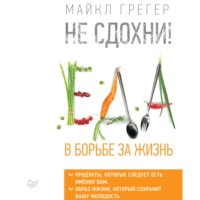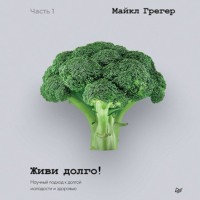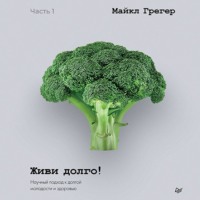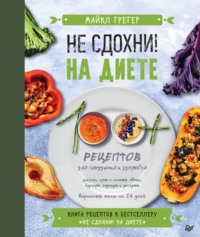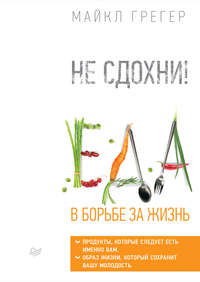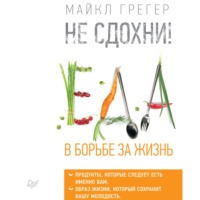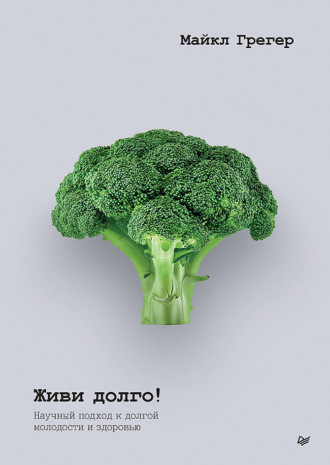
Полная версия
Живи долго! Научный подход к долгой молодости и здоровью
Чай и трезвость
Что насчет напитков? Метаанализ влияния алкоголя на развитие остеопороза показал, что по сравнению с теми, кто воздерживается от употребления алкоголя, риск развития остеопороза у людей, выпивающих от одного до двух бокалов в день, повышается на 34 %[3247]. При употреблении более двух бокалов в день этот риск возрастает до 63 %, что, по-видимому, приводит к увеличению риска перелома бедра[3248]. Это может быть частично связано с негативным влиянием алкоголя на здоровье костей, а также с риском падения из-за нарушения координации[3249].
По-видимому, сладкая газировка оказывает негативное влияние на костную ткань тем же способом, что и натрий[3250]: увеличивая потерю кальция с мочой[3251]. Однако, по-видимому, дело не в кофеине: три и более чашки кофе в день удваивают шансы на перелом бедра, а употребление чая их значительно уменьшает[3252]. В рандомизированном исследовании было обнаружено обнадеживающее улучшение маркеров формирования костной ткани у женщин[3253] и увеличение фактической костной массы у крыс, которым давали чай[3254]. Однако в самом крупном и продолжительном клиническом Миннесотском исследовании влияния экстрактов зеленого чая на женщин в постменопаузе не было обнаружено существенного влияния чая на минеральную плотность костной ткани[3255].
Орехи и кости
Исследователи из всемирно известной лаборатории доктора Дэвида Дженкинса подвергли остеокласты – клетки, разрушающие кости, – воздействию крови, полученной до, а также через 4 часа после употребления горсти миндаля. Подробности в видео see.nf/bonenuts. Выяснилось, что миндаль может помочь предотвратить потерю костной массы, но не укрепить кости[3256], в то время как для чернослива было обнаружено обратное – так что, возможно, стоит приготовить вкусный микс из чернослива и миндаля.
Эстрогены против фитоэстрогенов
Когда серия исследований под названием «Инициатива в области охраны здоровья женщин» (Women's Health Initiative) показала, что у женщин в менопаузе, принимающих заместительную гормональную терапию, «повышается частота рака молочной железы, сердечно-сосудистых заболеваний и происходит общее ухудшение самочувствия», прозвучал призыв к поиску более безопасных альтернатив[3257]. Да, исследование показало, что дополнительный эстроген действительно оказывает положительное влияние, например уменьшает климактерические симптомы, улучшает здоровье костей и снижает риск перелома бедра, но отрицательные эффекты включают повышенный риск образования тромбов в сердце, мозге и легких, а также рак молочной железы[3258].
В идеале, чтобы убить двух зайцев, нам нужен так называемый селективный модулятор эстрогеновых рецепторов – нечто, обладающее проэстрогенным действием в одних тканях, в частности в костной, но в то же время антиэстрогенным действием в других тканях, например, молочной железы[3259]. Компании, производящие лекарства, пытаются создать такие препараты, но фитоэстрогены, содержащиеся в соевых бобах, например генистеин, структурно сходный с эстрогеном, по-видимому, функционируют как естественные селективные модуляторы эстрогеновых рецепторов. Как может то, что похоже на эстроген, действовать как антиэстроген?
В своем видеоролике see.nf/phytoestrogens я объясняю, как соя может работать в двух направлениях благодаря наличию в организме двух разных типов эстрогеновых рецепторов, – происходит укрепление костной ткани без риска образования тромбов[3260] и рака[3261]. Проведенный в 2020 году метаанализ более пяти десятков рандомизированных контролируемых исследований соевых фитоэстрогенов у женщин в постменопаузе выявил значительное повышение минеральной плотности костной ткани в тазобедренном суставе, позвоночнике и запястье по сравнению с контрольной группой[3262]. При сравнении с гормонозаместительной терапией этот эффект был сопоставим[3263]. Например, в двухлетнем исследовании соевое молоко сравнивали с трансдермальным прогестероновым кремом и контрольной группой плацебо. Контрольная группа за 2 года значительно потеряла минеральную плотность костной ткани в позвоночнике, в то время как группа, принимавшая прогестерон, потеряла значительно меньше. Однако в группе, выпивавшей по два стакана соевого молока в день, костной ткани в итоге оказалось больше, чем в начале исследования[3264].
Соевое молоко по сравнению с рисовым и молочным обладает дополнительными преимуществами: снижает риск развития рака молочной железы[3265] и предстательной железы[3266], улучшает состояние кишечника[3267], уменьшает воспаление[3268] и повреждение ДНК свободными радикалами[3269]. Кроме того, оно может бороться с инсулинорезистентностью[3270] и помогать в реабилитации после инсульта, повышая скорость ходьбы, выносливость к физическим нагрузкам, силу хвата и функциональность мышц[3271], а также снижать артериальное давление лучше, чем коровье молоко[3272]. Соевое молоко может даже снизить уровень холестерина ЛПНП на 25 % всего за 21 день[3273]. С точки зрения питания соевое молоко считается лучшим выбором для замены коровьего молока в рационе человека[3274].
Причина, по которой мы заботимся о костной массе, заключается в том, что мы хотим предотвратить переломы. Молочные продукты также могут повышать плотность костной ткани[3275], но это не приводит к снижению риска переломов бедра[3276]. Соевые продукты, однако, на 20–50 % снижают риск переломов у женщин[3277], даже если употреблять одну порцию сои в день, что эквивалентно всего 5–7 г соевого белка, или 20–30 мг фитоэстрогенов[3278], или примерно чашке соевого молока, а еще лучше – одной порции цельного соевого продукта, такого как темпех, эдамаме или сами зрелые бобы[3279]. У нас нет точных данных о соевых добавках, но в любом случае лучше придерживаться цельных продуктов, а не принимать таблетки или порошки, тем более что при тестировании идентичных по маркировке коммерческих соевых добавок с изофлавонами были обнаружены «огромные различия» в содержании последних[3280].
А что насчет «антинутриентов» в фасоли?
Так называемые антинутриенты – это соединения растений, которые якобы снижают усвоение питательных веществ. Однако недавно вся эта концепция была поставлена под сомнение, и некоторые из этих соединений на самом деле могут быть полезными[3281]. Подробности в ролике see.nf/milks.
Кости и растительная пища
Поскольку исследования показывают, что повышенное потребление растительной пищи связано с увеличением минеральной плотности костной ткани[3282], в то время как потребление животной пищи связано с повышенным риском переломов, можно было бы ожидать меньшего развития остеопороза у тех, кто питается растительной пищей. Однако данные неоднозначны[3283]. В ролике see.nf/vegbone я рассматриваю имеющиеся данные за последние полвека.
Вегетарианцы и веганы, как правило, имеют более низкую минеральную плотность костной ткани по сравнению с мясоедами[3284], однако при учете размера тела эта разница практически исчезает. Таким образом, дело не столько в составе рациона вегетарианцев и веганов, сколько в том, что они, как правило, гораздо стройнее[3285].
Риск перелома бедра снижается по мере увеличения веса. Например, остеопороз встречается почти у половины женщин с недостаточной массой тела, но менее чем у 1 % женщин с ожирением, что совершенно логично[3286]. Ожирение заставляет организм делать кости более крепкими, чтобы нести на себе лишние килограммы. Вот почему так важны упражнения с отягощениями: они постоянно дают нагрузку на скелет. А у вегетарианцев, особенно у веганов, в среднем значительно ниже и вес, а плотность костей. Но означает ли это повышенный риск переломов?
Я рассматриваю все данные по переломам в своем видеоролике see.nf/vegfractures. Короткий ответ – да[3287], и не только потому, что веганы обычно более стройные[3288], но и из-за сниженного статуса витамина D и потребления кальция[3289]. Я рекомендую принимать 2000 МЕ дополнительного витамина D в день тем, кто получает недостаточное количество солнечного света[3290] и не менее 600 мг кальция ежедневно[3291] из богатых кальцием растительных продуктов, предпочтительно темно-зеленых листовых овощей с низким содержанием оксалатов, к которым относятся все виды зелени, кроме шпината, мангольда и свеклы. (Все это очень полезные продукты, но скупые на кальций.)
Физическая нагрузка
Когда речь идет о здоровье костей, то тут уж, как говорится, либо используй, либо теряй. Вот почему космонавты могут терять по 1 % костной массы каждый месяц пребывания вне Земли[3292]? Их организм не глуп. Зачем тратить столько энергии на создание прочного скелета, если ты просто паришь в невесомости и не даешь телу никакой нагрузки? Физическая активность считается «широкодоступным, недорогим и легко модифицируемым средством оздоровления костей»[3293]. Однако одни упражнения более эффективны, чем другие, о чем я подробно рассказываю на see.nf/weightbearing.
О йоге
Считается, что такие статические виды активности, как йога, не способствуют образованию костной ткани[3294], хотя есть исследования[3295], утверждающие обратное. (Подробности смотрите на see.nf/yogabones.) На самом деле йога может даже привести к компрессионным переломам позвонков. К безопасным позам относятся позы с легким вытяжением позвоночника и растяжением ног, например поза воина; позы, которых следует избегать, включают экстремальное сгибание или разгибание позвоночника (например, поза верблюда), напряжение шеи (например, поза плуга) или напряжение поясницы/бедер (например, поза одноногого голубя), которые могут вызвать переломы даже у людей с нормальной или почти нормальной плотностью костной массы[3296].
По данным систематического обзора, включавшего более 9000 человек, практикующих йогу, риск травм, связанных с йогой, ниже, чем при занятиях более интенсивными видами спорта[3297], такими как бег[3298], за исключением повреждения мениска колена, предположительно связанного с позами йоги, такими как поза лотоса[3299]. Горячая (бикрам) йога сопряжена с определенным риском[3300]. Смотрите в ролике see.nf/yogarisk список рекомендаций по безопасности.
Важнейшая мера профилактики остеопоротических переломов
Скрининг минеральной плотности костной ткани – это индустрия с миллиардными оборотами[3301], поэтому не стоит удивляться тому, что именно он находится в центре внимания специалистов по остеопорозу и его лечению. Однако среди женщин в возрасте 65 лет и старше только 15 % малотравматичных переломов (то есть переломов при падении с высоты собственного роста) обусловлены остеопорозом[3302]. В возрасте от 60 до 80 лет риск перелома бедра увеличивается в 13 раз у мужчин и женщин, в то время как возрастное снижение минеральной плотности костной ткани обусловливает лишь двукратное увеличение риска[3303]. Таким образом, 85 % возрастного повышения риска перелома бедра никак не связано с плотностью костей.
Без падения даже хрупкие бедра не переламываются. Основной причиной переломов, в том числе переломов позвонков, являются падения[3304]. Разница между мужчинами и женщинами в частоте переломов бедра объясняется, по-видимому, не тем, что у мужчин более прочные кости, а тем, что женщины чаще падают[3305]. Врачи, просто задав вопрос «Есть ли у вас нарушения равновесия?», могут предсказать около 40 % всех переломов бедра[3306], что больше, чем диагностика остеопороза с помощью сканирования костей[3307]. Даже слабая остеопоротическая кость достаточно прочна, чтобы выдержать обычную жизнедеятельность без чрезмерной нагрузки, возникающей при падении или, в случае позвоночника, при сгибании спины, а не коленей, чтобы поднять что-то[3308].
Лидирующее положение падений в списке причин переломов объясняет ряд очевидных парадоксов остеопороза. Например, несмотря на то что около 70 % костной массы определяется генами[3309], наследственность переломов бедра кажется незначительной[3310], поскольку склонность к падениям наследуется в гораздо меньшей степени[3311]. Это также объясняет низкую прогностическую ценность DXA-сканирования в отношении переломов. Добавление показателей минеральной плотности костной ткани к оценке риска переломов бедра, основанной только на знании возраста, пола, роста, веса, факта использования для ходьбы трости или ходунков и курения сигарет, практически не улучшило ее прогностическую способность[3312]. В провокационной редакционной статье, опубликованной в Journal of Internal Medicine под названием «Osteoporosis: The Emperor Has No Clothes» («Остеопороз: а король-то голый»), высказалось предположение, что безопаснее и эффективнее было бы сосредоточиться на профилактике падений, а не на фармацевтическом вмешательстве[3313].
Хотя только около 5 % падений приводят к перелому, падения очень распространены среди пожилых людей[3314]. Отчасти из-за возрастной мышечной слабости и потери равновесия ежегодно падают[3315] более трети людей в возрасте 65 лет и старше[3316]. После перелома бедра менее 50 % людей могут восстановить двигательную функцию, как она была до перелома [3317]. Что мы можем сделать для предотвращения травматических падений? Упражнения[3318]. По данным десятков рандомизированных контролируемых исследований, физическая нагрузка является единственным проверенным средством снижения частоты падений[3319].
Как предотвратить падения
По результатам 81 исследования, те, кто занимался физическими упражнениями, снизили частоту падений на 23 % по сравнению с контрольными группами, а число людей, которые в итоге упали, уменьшилось на 15 %. Таким образом, если в течение года проследить за 1000 человек в возрасте около 75 лет, то окажется, что 480 из тех, кто не тренировался, упали в общей сложности 850 раз. Тренировки должны привести к уменьшению числа упавших на 72 человека и сокращению числа падений на 195. Оказалось, что тайцзы снижает количество падений на 19 %, упражнения на равновесие и функциональные упражнения (например, упражнения «вставание из положения сидя») – на 24 %, а комбинированные упражнения – как правило, упражнения на равновесие и функциональные упражнения плюс силовые тренировки – могут снизить количество падений на 34 %[3320].
Такое снижение приводит к уменьшению числа переломов. Недавний метаанализ показал, что физические упражнения, в основном использующие комбинацию упражнений с сопротивлением, направленных на повышение силы мышц нижних конечностей и тренировку равновесия, уменьшают частоту переломов почти в 2 раза[3321]. Одно годичное исследование, в котором силовые тренировки сочетались со степ- и прыжковой аэробикой, направленной на развитие равновесия и ловкости[3322], привело к снижению числа переломов на 74 % в течение 5 лет после окончания исследования[3323]. Более 70 % женщин из группы упражнений не имели ни одного травматического падения в течение этих 5 лет по сравнению с более чем половиной женщин из контрольной группы, с которыми падения случались.
Проводившиеся испытания протекторов бедра (обычно это пластиковые щитки или поролоновые подушечки, вшитые в специальное белье для амортизации бокового падения на бедро) не показали значимого эффекта, что, возможно, связано с неудобствами их использования и отказом от них из-за дискомфорта, особенно в постели[3324]. Исследования не выявили снижения частоты переломов бедра среди людей, живущих дома и использовавших протекторы, но испытания в домах престарелых и интернатах выявили небольшое снижение риска – уменьшение числа переломов бедра примерно на 11 человек из тысячи благодаря ношению защитного белья[3325].
Существуют и более простые бытовые приемы, которым нужно обучить пациентов, и одно способно снизить частоту падений на 10 %[3326]. Например, мы можем держать вещи в пределах досягаемости, чтобы не пользоваться табуретками, использовать нескользящие коврики в ванной и душе[3327], установить в ванной комнате поручни, не загромождать пол, убрать маленькие коврики или использовать двусторонний скотч, чтобы они не скользили, и убедиться, что все лестницы имеют поручни и достаточное освещение[3328]. Кроме того, следует избегать прогулок в ненастную погоду, а тем, кто выгуливает собак на поводке, надо подумать о собаках более мелких пород или выдрессировать их так, чтобы они не делали рывков, сбивающих хозяина с ног[3329].
В остальном же способы профилактики переломов не претерпели существенных изменений за последние 30 лет, с тех пор как в классической статье «Стратегии профилактики остеопороза и переломов бедра»[3330] нас призывали «бросить курить, вести активный образ жизни и правильно питаться»[3331].
Сохранение функции кишечника и мочевого пузыря
Древний Египет, просуществовавший более 3 тысяч лет, был одной из величайших ранних цивилизаций. Знания древних египтян в области медицины, которая включала в себя даже медицинские специальности, сильно недооценены. Например, фараоны имели доступ к специальным врачам, которые служили «хранителями царского кишечника»[3332], что в альтернативном переводе с иероглифов означает «пастух ануса»[3333]. Как вам такой вариант составления резюме?
Сегодня здоровью кишечника уделяется повышенное внимание. Некоторые специалисты призывают рассматривать ритмичность работы кишечника наряду с частотой сердечных сокращений, артериальным давлением и частотой дыхания как жизненно важный признак функционирования организма[3334]. Оптимальной частотой, как показано в ролике see.nf/bms, является два-три опорожнения кишечника в день. Однако самым важным критерием для постановки диагноза «запор» является не частота[3335], а наиболее распространенный симптом – напряжение[3336]. В идеале опорожнение кишечника должно происходить без усилий.
Запор
Запоры считаются наиболее распространенной желудочно-кишечной патологией в США[3337], ежегодно приводящей к миллионам обращений к врачам[3338] и 800 тысячам посещений отделений неотложной помощи[3339]. Пожилые люди подвержены повышенному риску, что, возможно, связано с уменьшением количества пищевых волокон, жидкости и физической активности[3340]. Запорами страдают до 30 % людей в возрасте 65 лет и старше, до 50 % людей старше 85 лет[3341] и до двух третей людей, проживающих в гериатрических учреждениях[3342]. Помимо твердого стула и нечастых опорожнений кишечника симптомы запора могут включать дискомфорт и боль в животе, вздутие, тошноту и ректальное кровотечение во время дефекации[3343]. Несмотря на то что зачастую это может быть доброкачественным явлением, при любых признаках крови в туалете следует обязательно обратиться к врачу. К другим тревожным симптомам относятся внезапная потеря веса более чем на 10 % за 3 месяца, семейный анамнез воспалительных заболеваний кишечника или рака толстой кишки, желтуха, появление новых симптомов в возрасте после 50 лет и тенезмы прямой кишки – ощущение невозможности опорожнить кишечник, хотя в нем ничего нет.
Не напрягайтесьСистематический обзор влияния запоров на жизнь людей показал, что снижение качества жизни из-за этой проблемы сопоставимо с тем, что испытывают люди, страдающие такими заболеваниями, как остеоартрит, ревматоидный артрит, хроническая аллергия и диабет[3344]. Несмотря на то что эта проблема осложняет повседневную жизнь, опросы показывают, что многие взрослые американцы, страдающие хроническими запорами, никогда не обсуждали свои симптомы с медицинским работником. Табу, по-видимому, действует в обе стороны, поскольку медицинские работники редко уделяют достаточное внимание работе кишечника[3345], что было признано консенсусной группой экспертов «серьезным упущением» медицинских специалистов[3346].
Люди, которые не считают, что страдают от запоров, вполне могут занижать серьезность проблемы[3347]. Например, в одном из исследований, проведенных в штате Огайо, четверть так называемых здоровых испытуемых сообщили о неполном опорожнении кишечника, а почти половина – о повышенном напряжении при дефекации[3348] – настолько, что многие из них в течение последнего года находили кровь на своей туалетной бумаге.
Напряжение при дефекации, конечно, может вызывать дискомфорт, но помимо боли, твердый стул может способствовать возникновению целого ряда проблем со здоровьем. Например, каждый пятый американец страдает от хиатальных грыж[3349] – состояния, при котором часть желудка проталкивается вверх и через диафрагму попадает в грудную клетку. Среди населения, придерживающегося растительной диеты, хиатальные грыжи встречаются редко, их частота приближается к одному случаю из тысячи[3350]. Почему такое большое расхождение?
У людей, питающихся растительной пищей, как правило, мягкий и обильный стул. Если вы постоянно напрягаетесь во время опорожнения кишечника, то со временем повышенное давление при выталкивании кала может вытолкнуть часть желудка вверх и за пределы брюшной полости, что приведет к рефлюксу кислоты в горло и будет вызывать приступы изжоги[3351]. Напряжение при опорожнении кишечника может вызвать и другие проблемы, включая геморрой и варикозное расширение вен[3352], а также анальную трещину и другие болезненные состояния[3353].
Приходилось ли вам когда-нибудь сжимать мячик для снятия стресса? Если да, то вы знаете, как при его сжимании рукой поверхность мяча выпячивается там, где давление слабее. Аналогичным образом давление при дефекации может привести к выпячиванию стенок толстой кишки, что называется дивертикулезом. Повышенное давление в брюшной полости может также усилить кровоток в венах вокруг ануса, вызывая геморрой, и даже оттеснить кровоток в ноги, что приводит к варикозному расширению вен[3354]. Однако диета, богатая клетчаткой, может уменьшить давление в обоих направлениях. Те, кто придерживается диеты, основанной на употреблении цельной растительной пищи, чаще совершают опорожнения кишечника[3355], что приводит к более чем двадцатипятикратному снижению распространенности «болезней давления», таких как дивертикулит, геморрой, варикозное расширение вен и хиатальная грыжа[3356].
Длительное напряжение может также вызвать нарушения сердечного ритма и снижение притока крови к сердцу и мозгу, что чревато обмороком при дефекации и даже, при определенных обстоятельствах, смертью[3357]. Всего пятнадцать секунд напряжения могут временно сократить приток крови к мозгу на 21 %[3358] и к сердцу – почти на 50 %, вызывая такой синдром, как «смерть в туалете»[3359]. Если вы считаете, что вам приходится сильно напрягаться в положении сидя, представьте, каково это – совершить опорожнение кишечника, лежа на спине. Всего несколько секунд в положении лежа могут привести к повышению артериального давления почти до 170 на 110, что, возможно, объясняет печально известную частоту внезапных и неожиданных смертей пациентов в больницах при использовании уток[3360].
При неадекватном лечении запор может привести и к прободению толстой кишки, что потребует экстренной госпитализации[3361]. Пожилые люди, столкнувшиеся с проблемой «наполовину внутри, наполовину снаружи»[3362], могут попытаться провести пальцевую дезимпакцию – удалить кал вручную, что может быть болезненным, мучительным и потенциально вредным занятием[3363]. Оптимальным средством является профилактика запоров.
Лучшая поза для опорожнения кишечника при запорах
А как влияет положение тела на дефекацию? В некоторых регионах Азии и Африки традиционным положением остается сидение на корточках, а жители Запада привыкли сидеть на сиденье унитаза. Однако когда вы сидите прямо, ваш «аноректальный угол» недостаточно выпрямляется. Этот изгиб на конце прямой кишки помогает нам не обкакаться. При сидячей позе на унитазе кал должен поворачиваться почти на девяносто градусов, что сводит на нет смысл этой великолепной конструкции[3364]. Попытка дефекации сидя подобна попытке управлять автомобилем, не отпуская стояночный тормоз[3365]. Все исследования можно найти в видео see.nf/positioning. Мы можем манипулировать аноректальным углом, приседая или наклоняясь, чтобы облегчить прохождение неестественно твердого стула, но почему бы просто не устранить причину? Если есть достаточное количество цельной растительной пищи, содержащей клетчатку, то стул будет настолько мягким, что сможет без усилий проходить под любым углом[3366].
Эффективность слабительных средствОтчаянно пытаясь вылечить запоры, люди создают различные медицинские устройства – от автоматических массажеров для живота, закрепляемых на талии[3367], до вибрирующих капсул, которые, будучи проглочены, массируют вас изнутри[3368]. Более того, растет число колэктомий из-за хронических запоров[3369]. Осложнения при резекции толстой кишки возникают примерно в каждой четвертой операции, а одна из двухсот пятидесяти операций заканчивается летальным исходом[3370]. Однако наиболее распространенными методами лечения являются безрецептурные слабительные средства, оборот от продаж которых превышает миллиард долларов в год[3371].








